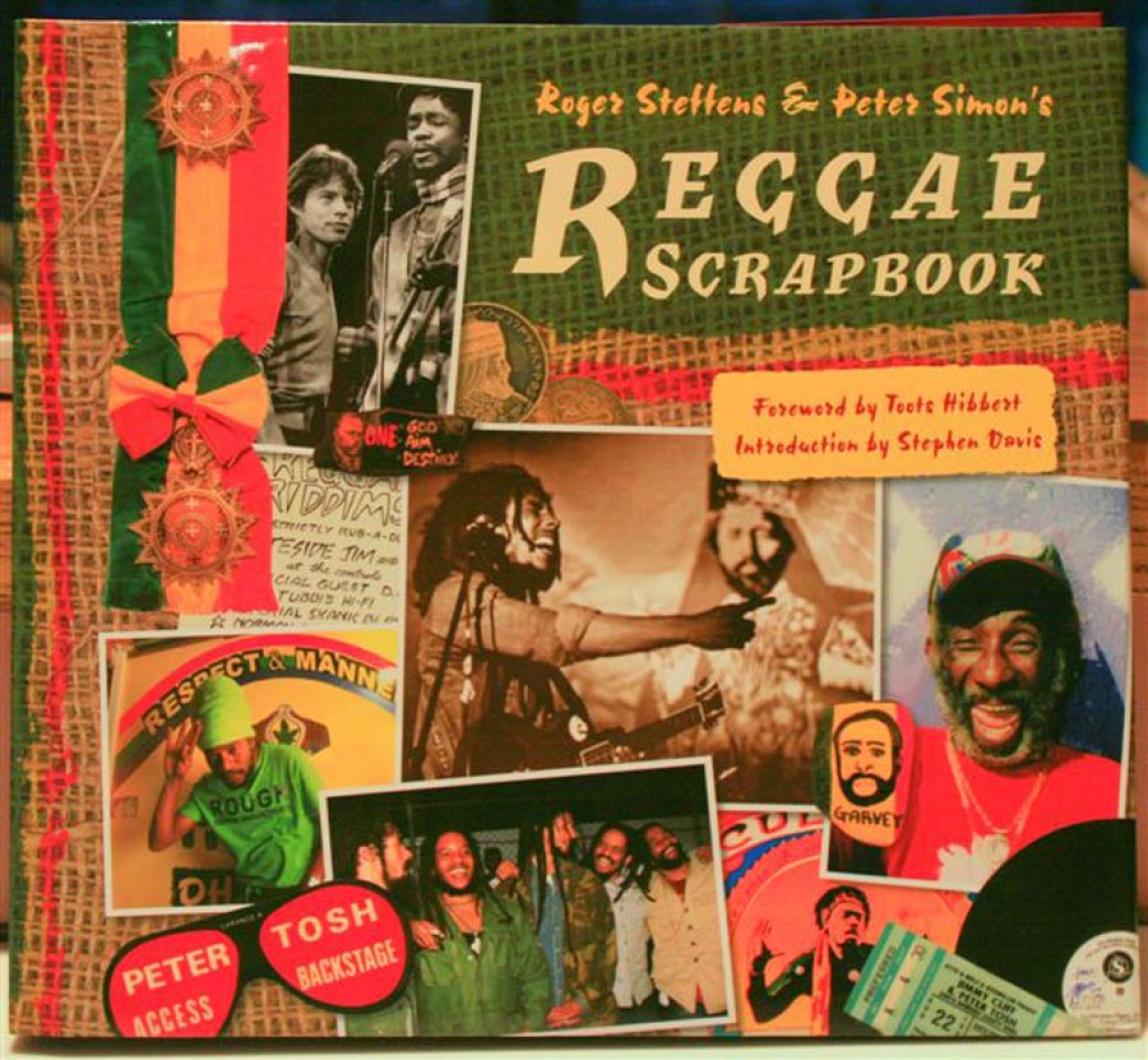REGGAE SCRAPBOOK. By Roger Steffens and Peter Simon. Insight Editions. San Rafael, Calif.. 2007. 154 pages. $45 hardcover with DVD.
Roger Steffens and Peter Simon’s Reggae Scrapbook is a treasure trove of information, memorabilia and dazzling photos of all things reggae. Reggae is the predominately dance music that originated in Jamaica, mixing African, Caribbean, American rhythm and blues influences. Its lyrics can deal with a variety of subjects such as the standard song topics of love, faith and relationships but also can cover social issues such as religion, poverty, justice and political empowerment. It is a musical genre that is relatively modern, beginning in the early Sixties, and has evolved into a major influence on a range of musical styles including rock, hip hop, electronic and dance music on an international scale.
The authors have a unique and impressive personal history in the world of reggae music. Roger Steffens is the founding editor of one of the leading magazines of reggae and world beat music, The Beat. His articles about reggae have appeared in publications such as Spin, Rolling Stone, the New York Times and the Village Voice. He has hosted radio and television programs in his home in Los Angeles that have been syndicated around the world. Mr. Steffens is considered by many, through his exhaustive collection of records, videos and personal connections, to be the leading expert of this relatively new musical genre. Island resident Peter Simon’s award-winning photographs have been showcased and featured around the world in such publications as Time, Newsweek, New York Magazine, the New York Times and Rolling Stone. He is co-author with Stephen Davis of the two seminal books on reggae, Reggae Bloodlines and Reggae International. Hosting several radio programs throughout the Northeast, Mr. Simon also has featured reggae on WMVY here on the Vineyard. He has produced reggae records for artists such as Toots Hibbert — who coined the word “reggae” and who contributes the foreword for the Reggae Scrapbook.
Together Mr. Steffens and Mr. Simon present a crash course on reggae, its most influential stars, how it started, and where it is going. As they state early on, “the book is not, however, an encyclopedic attempt to touch all the thousands of interesting bases erected in the far-flung corners of reggae world ... the contents reflect our very personal memories and observations.” The personal memories and observations include stories and photos of its biggest stars, including Bob Marley, Toots, Peter Tosh and Jimmy Cliff. They also present primers on the Rastafari Movement (the religion so integral to many reggae artists), the importance of marijuana as one of its sacraments, the cutthroat business of Jamaican record production, and anecdotal examples of crime and punishment in Jamaica.
The section on Marley alone is one of the best short histories of his life and what his influence is on reggae and the world. Many books have been written on this cultural icon, including a couple by Mr. Steffens. The authors do an excellent job of explaining Marley’s importance and his context to the times and music, while not letting his individual stature overpower the rest of the stories they have to tell. The future of reggae is covered with sections on current artists such as Morgan Heritage, Lady Saw, Buju Banton and the various Marley offspring. Much of this current information was acquired by Mr. Simon and his son Willie in January of this year, when he revisited many of the places in Jamaica he originally explored in the seventies while researching his earlier books.
The book is truly a scrapbook, and the authors have included a variety of their personal treasures and memorabilia with facsimiles of old postcards, concert fliers, ticket stubs, reproductions of vinyl 45s with their original artwork and autographs, buttons/badges, movie posters and stickers. There is, too, an hour-long DVD of some of the interviews Mr. Steffens produced for his television program featuring the Wailers, Peter Tosh, Joseph Hill of Culture, Judy Mowatt and others. One does wish that the DVD featured a subtitles option, as the thick patois of some of the speakers is almost impenetrable. The interview with Ms. Mowatt, who was one of Bob Marley’s backup singers, the I-Three, is particularly fascinating. Ms. Mowatt tells the story of the riot that occurred when Bob Marley and the Wailers were invited to perform at the Independence Day Celebration when the African nation of Zimbabwe gained independence from Britain.
Mr. Steffens tells short stories of interest about each of the artists featured. Some of them are in the first person, such as the one he relays of Joseph Hill explaining the lyrics of his most famous song, Two Sevens Clash. Some are straight interviews with the musicians, like Dennis Brown explaining how he got started making records. Others are stories told by musicians who were present at pertinent moments; Beverly Kelso, one of the original Wailers tells of what it was like to rehearse with Bob Marley. Mr. Steffens provides background and color to the songs and musicians that he has found most memorable, and if you enjoy reggae, you’ll find them entertaining and enlightening.
Mr. Simon’s photos of the artists are wonderful throughout, and some of the images of Marley, Tosh, Big Youth and Gregory Isaacs are positively classic. It is obvious that the subjects are comfortable with their photographer, and this allows a powerful honesty in the photos that must be difficult to attain with artists whose distrust of outsiders seems so obvious. The shots of kids playing in the streets, vendors selling their goods at the market, and other scenes of everyday life in poverty display Mr. Simon’s keen vision and understanding that this is the world that the musicians play to and escape from.
The Reggae Scrapbook is a great gift for anyone who loves reggae music or a terrific way for anyone who is intrigued by it to learn more about it from authors who clearly love their subject.
Peter Simon will sign copies of this book and his other books, calendars and compact discs at this weekend’s Artisans Festival, and at Outerland on Friday night between sets of the reggae band, Prezident Brown.







Comments
Comment policy »